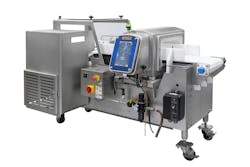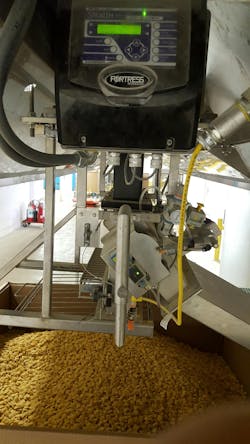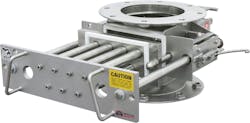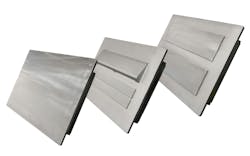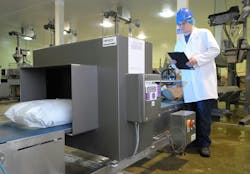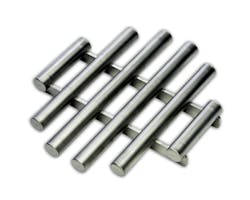Inspection system basics for bulk solid food processes
Foreign contaminants in food products can be dangerous for consumers and can lead to costly product recalls for food manufacturers. Using magnetic separators, metal detectors, and X-ray inspection systems to detect and remove foreign materials from the process stream is critical to ensure that contaminated products do not end up on supermarket shelves.
To understand how detection and separation systems operate and their application in powder and bulk solids foods processes, Processing reached out to experts from three leading suppliers of these types of devices and systems: Industrial Magnetics, Inc. (IMI), a provider of permanent magnets and electromagnets based in Boyne, Michigan; Eriez, a Pennsylvania-based supplier of magnetic separation, metal detection, and material handling equipment; and Fortress Technology, a provider of metal detectors, X-ray systems, and checkweighers headquartered in Toronto, Ontario.
According to Craig Lorei, global market manager — Light Industry at Eriez, the types and sources of foreign materials that can infiltrate bulk solid food processes vary significantly depending on the specific product being handled or produced. “Among the most prevalent types are metals, plastics, and wood,” Lorei says, “And they come from various sources, including incoming raw ingredients, machinery within the manufacturing plant, or even items inadvertently misplaced or introduced by personnel working in the facilities.”
Early detection of potential contaminants in the raw material feeds is important, because larger contaminants such as metal flakes, bolts, plastic pieces, nutshell fragments, fruit pits and stones can be broken up by process equipment and dispersed as smaller particles throughout the material stream. As Eric Garr, regional sales manager at Fortress Technology points out, “Large contaminants can also damage processing equipment, resulting in downtime, expensive repairs or even machinery replacements.”
Garr says that metal remains the most common contaminant on food processing lines, largely due to high levels of automation in production plants. “If processing equipment is not properly maintained,” he says, “this increases the risk of metal fragments entering a production line.”
Detection system operation
Metal detection systems operate by generating an electromagnetic field around a nonmetallic aperture and then continuously monitoring that field for disturbances or deviations caused by metal objects as material passes through the aperture. “While the specific methods for measuring, monitoring, and identifying changes in the electromagnetic field may vary among equipment manufacturers, the fundamental principle remains consistent across different systems,” says Lorei. “Essentially, the metal detector identifies deviations in the electromagnetic field caused by the presence of metallic objects, enabling the system to signal the presence of metal contaminants in the inspected material.”
An X-ray machine identifies contaminants in a material by detecting variations in density. This allows the machine to detect contaminants such as glass, ceramic, and bone, but means that the machine can miss some items such as lightweight foil strips found in PPE and very thin box blades. “Although effortless to a metal detector,” says Garr, “there’s not enough density differential between the lower density metal and the product being inspected for an X-ray to identify these types of contaminants.”
“The decision to invest in X-ray or metal detection equipment,” Garr continues, “is dependent upon a manufacturer’s requirements based on a risk analysis of potential contaminants in their line. Both technologies come with their own advantages; neither should be a replacement for good manufacturing practices. Rather, food contaminant detection units should always complement the process based on needs and risks.”
Garr says that, while metal detectors can be designed to suit most types of applications, such as conveyor belts, gravity/free fall, and pipelines, X-ray systems are available only in conveyor and pipe formats, so the application and packaging used will determine whether an X-ray system is suitable. He adds that replacing a metal detector with an X-ray machine is not a good idea because users will lose “virtually all detection” of low-density metals unless “a very large chunk” presents itself. Also, as bulk solids processes tend to generate dust, heat and temperature extremes that can shorten an X-ray’s life span, X-ray machines generally are not used upstream in food processing areas and are instead placed at the end of processing lines after packaging as a final safeguard.
Magnet separators
Permanent magnet separators such as grate-, tube-, or plate-style magnets are often used near the beginning of the manufacturing process to separate contaminants in raw materials and ingredients. Joe Skafar, regional manager at IMI, says that his company uses drawer-in-housing style magnets whenever possible, with 1-inch-diameter tubes staggered on 2-inch centers as the standard configuration. He says that IMI also has other configurations more suitable for high-volume applications or for materials with poor flowability such as plant-based proteins or flour. The drawers contain a series of magnetic bars that run directly across the material stream, so that the passing material comes into close or direct contact with the magnets for highly efficient separation. The drawers are then periodically slid open to allow for the removal of captured contaminants. Skafar says that drawer magnets with a double row of bars can catch nearly 100% of contaminants.
“It is standard for food-grade magnets to be rare earth, which is the strongest available,” Skafar notes. “Rare earth magnets will capture large metals as well as metallic fines and dust. The magnet chosen will suit your application based on the flow rate, granule size, and flowability; how the magnet is being fed (silo, bucket elevator, etc.); and the vertical or angled drop.”
Plate-style magnets are most commonly used in situations where larger metal contaminants may be present, such as wires, nuts, and bolts. Lorei notes that plate-style magnets are often installed in chutes or at conveyor discharge points and are “preferred for materials prone to build up or those with restricted flow characteristics. They provide effective removal of ferrous contaminants while ensuring smooth material flow within the processing line.”
Inspection and separation equipment selection
To determine the best inspection and separation technology to use for a given manufacturing process, Skafar recommends consulting with an equipment supplier. “Consulting with a magnet supplier will provide the best route to determining the most suitable technology for the feed material, flow characteristics, feed rate, feed method and expected contamination,” he says.
Lorei says that the optimal inspection and separation technology for a given process depends largely on the specific types of foreign materials targeted for removal but notes that best practice often involves the use of multiple technologies in series throughout the production line. “For instance,” Lorei says, “while a metal detector can identify all metals (ferrous, non-ferrous, and stainless steel), a high-powered magnet excels at extracting minute ferrous particles that may evade detection by the metal detector.”
According to Garr, determining the biggest contaminant risks and most cost-efficient critical control points (CCPs) and inspection solutions helps to create a robust food safety strategy that complies with Hazard Analysis and Critical Control Points (HACCP) principles, maximizes profitability, and minimizes product waste.
“For loose and raw products, such as potato chips, cereal, corn, popcorn, and snacks, inspection CCPs will often take place before the bagging stage using a gravity/vertex metal detector, and then later down the line when bags are sealed, just before packing into boxes for distribution,” Garr says. “Leaving the inspection until the end of the production line could result in high levels of false rejects and unnecessary disposal of good product and packaging.”
Garr adds that inspecting bulk ingredients before they reach the processing stage, typically using bulk gravity and large bag inspection systems can also minimize finished product rejects. While raw materials and ingredients are typically inspected by the supplier, “a reinspection is crucial to ensure that suppliers are complying and hold them accountable for ingredient quality.”
Garr also advises using bulk checkweighers to verify the weight of incoming ingredients in formats up to 50 kg and efficiently manage return rates.
Inspection and separation equipment placement
Skafar says that it is essential to place magnets at both receiving and loadout locations to ensure that all products entering and exiting the facility pass through a magnet. He also recommends installing magnets after each process step to capture any metal shavings or dust created by the processing equipment during operation or in case of equipment failure that could cause items such as nuts, bolts, or blades to inadvertently enter the material stream.
Lorei notes that optimal inspection and separation equipment placement within a process is not a one-size-fits-all endeavor and agrees that the most effective approach involves strategically deploying multiple systems at various stages of the production line to address different contamination risks.
In addition to inspecting incoming raw materials and after process steps such as grinding or mixing, Lorei recommends installing inspection equipment at the fill point to ensure that contaminants are not introduced into the final packaging as well as inspecting sealed and packaged products as a last line of defense before the products leave the facility.
As Garr explains, “HACCP guidance states that CCPs should be located at any step in the process where hazards can be prevented, eliminated, or reduced to acceptable levels. Rather than looking for patterns, examine potential CCP holes. This is even more critical if a production process or packaging is changing.
“An annual HACCP assessment — a requirement for most bulk processors and ingredient suppliers — will help to ensure that all essential inspection points are covered and determine the best places to install equipment on a line to ensure that a facility remains compliant for retail and food service.”
Ensuring compliance with food safety standards
When it comes to certification or compliance requirements for inspection and separation equipment used in food applications, Lorei says that the most important thing is for companies to ensure alignment with their own food safety management system (FSMS) and quality control requirements.
“Each industry and company has unique standards, often requiring collaboration with equipment vendors to specify the appropriate magnet or detector for the application,” says Lorei. “It is crucial to work closely with vendors to ensure that the chosen equipment meets the necessary standards and functionality while catering to the specific needs of each food production process. With a tailored approach, processors can effectively uphold food safety and quality throughout their operations.”
Garr emphasizes the importance of good recordkeeping and notes that end users are responsible for ensuring conformity to all safety regulations. “To satisfy the requirements of food safety regulators, retail codes of practice, and customer/supplier agreements,” he says, “both metal detectors and X-ray systems need to have records of performance available for audit purposes. For X-ray equipment, registration and safety logs are generally a requirement for each installation. Local and state authorities are sometimes required to perform a periodic inspection of the equipment. Processors should be careful to ensure that all safety codes and regulations are being complied with. Thorough personnel safety training and employee education is a requirement.”
Common inspection/separation mistakes
Common mistakes in the application of inspection and separation equipment range from improper equipment selection and installation to inadequate maintenance to missteps when modifying existing production lines. Skafar points out that, while selecting off-the-shelf equipment may seem convenient, such solutions often fail to meet a company’s unique needs. “It is important to consider all process parameters to ensure that the material will flow while achieving the desired metal capture,” he says. “Customized magnets can be precisely tailored and adjusted to address specific applications, delivering optimal results and satisfaction for customers.”
“Ensuring proper installation and easy servicing is crucial,” says Lorei, “and extra installation considerations are necessary for metal detectors to minimize false detections and ensure optimal functioning.”
Magnetic separators require regular cleaning of the captured metal debris to ensure peak performance. To ease cleaning and optimize efficiency, self-clean models are available that integrate seamlessly into a PLC for automated cleaning.
While acknowledging the importance of processing and inspection speeds, Garr says that production output should never supersede food safety. “Also, there can be a temptation to completely reconfigure production layouts,” he adds. “But this can be a costly undertaking; it can often be more efficient to deploy automated systems with self-test and diagnostics.”
“Where there might appear to be a need for multiple machines to cope with the increase in upstream output,” Garr continues, “Fortress recommends closely examining the options. For example, could a multi-lane system offer a better return on investment in a smaller footprint? Is it possible to channel multiple product lanes through a larger aperture? What sort of reject system is required? Modular systems provide greater flexibility and can allow processors to integrate electronics or upgrade metal detectors with newer software in seconds. For example, if installing a metal detector or checkweigher into an existing production line, can this be configured with legacy upstream or downstream equipment?”
By working with equipment suppliers to identify the CCPs in their processes where inspection and separation systems can be most beneficial and then ensuring their proper installation and maintenance, food manufacturers can safeguard their products for consumers — as well as their brand reputations — while preventing costly equipment damage and downtime.
Eriez
www.eriez.com
Fortress Technology
www.fortresstechnology.com
Industrial Magnetics
www.magnetics.com

